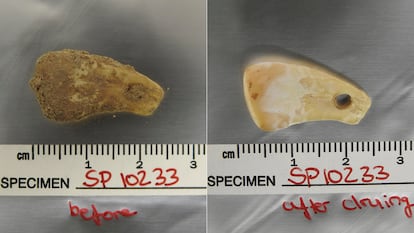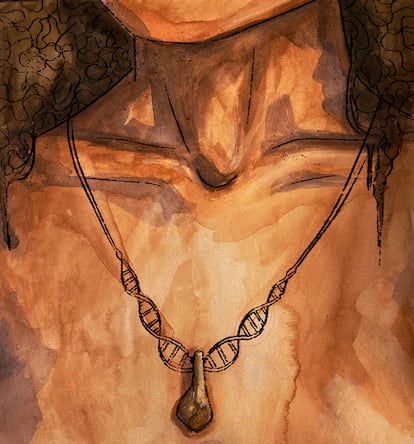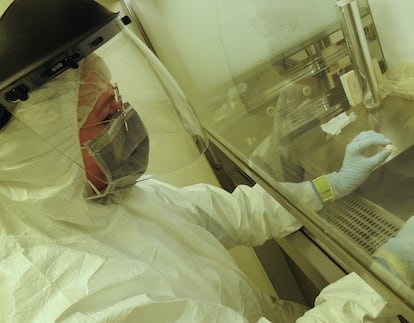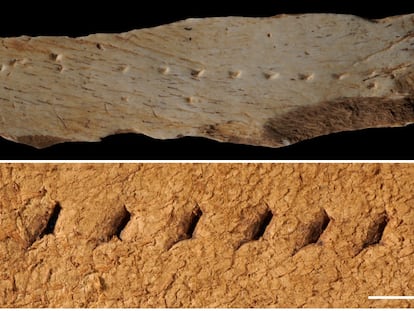New technique extracts woman’s DNA from the pendant she wore 20,000 years ago
The innovative method for obtaining genetic material allows us to link archaeological artifacts with the people who touched them

For forensic scientists, personal objects found at the scene of the crime are crucial: they may contain DNA that can identify the victim or even the murderer. But it’s not easy to recover genetic material from 20,000 years ago, and it’s an even taller order finding it in anything that someone wore on their body. Firstly, because most human creations such as clothes get lost over time. Secondly, because the artifacts that have been preserved are so valuable that traditional DNA extraction techniques cannot be used on them; as they are so aggressive in nature, they would endanger the objects. Now, however, German scientists have discovered that a person’s genetic information can be recovered from a pendant they wore, just by washing the item.
The pendant in question was discovered by Russian archaeologists in one of the Denisova Caves, in Siberia. This is the region that was inhabited by the Denisovans, a species of hominid that is thought to have lived alongside the Neanderthals and the ancestors of current humans. In 2019, in one of the caves, a carved, perforated animal’s tooth was discovered. Investigators had found an accessory probably made from a deer, which — because of the soil layer in which it was found — was believed to have been worn by someone between 20,000 and 30,000 years ago. In other words, when there were no more Denisovans or Neanderthals in this part of the world. But that was as far as their investigation could go, and the tooth became just another human creation added to the collection. However, in 2021, researchers at the Max Planck Institute for Evolutionary Anthropology published their findings on an innovative method for extracting DNA from bones and teeth without damaging them. On this occasion, the pendant itself is almost less important than the technique for analyzing it.
Elena Essel, a researcher at the Max Planck Institute, was involved in the development of this method. “For bone and tooth samples, you usually perforate a small orifice in the sample, to collect bone dust,” she said. “This dust is then used for the DNA extraction.” However, when you work with artifacts made from bones and teeth, “in many cases you can’t follow this destructive process, as it would ruin valuable information that the surface of these objects could provide,” Essel said.
The scientist explained that the structure of the surface can offer an idea of how these objects were made and how they were used. And she added: “This knowledge is fundamental to our understanding of human subsistence strategies, behavior and culture in the Pleistocene. So it’s crucial to preserve the integrity of the artifacts during extraction. That’s why we set ourselves the target of developing a DNA extraction technique that wasn’t destructive.”
Chemical solutions and gloves
After carrying out tests that involved washing a range of objects using several chemical solutions, they found that sodium phosphate extracted DNA without harming them. Before trying the technique out on the pendant, they used the solution to re-analyze a series of objects made from bone, dating back thousands of years and discovered during the 20th century. They managed to extract a large amount of genetic material, but the only DNA they identified belonged to the animal itself or modern-day humans; the samples had been contaminated. They therefore moved on to artifacts discovered in recent years, by which time investigators were working with far greater forensic discipline, using gloves, hats and masks to avoid their hands, sweat or even their breath from contaminating something that has remained intact for millennia.
As Essel and her colleagues outline in the scientific journal Nature, they applied their new method to bone and tooth pendants that had been excavated very carefully, attempting to avoid contamination. “In comparison with other solutions, sodium phosphate doesn’t dissolve the bone matrix to release the DNA,” Essel revealed. What the compound does is lend its phosphate to the bone and, by adding extra phosphate, it allows for the “release [of] DNA from the bone matrix without reducing the bone itself.”

Three of the pendants analyzed were from the Bacho Kiro Cave in Bulgaria, and the other was from the Denisova Caves. The four samples were submerged in a solution featuring sodium phosphate and washed at different temperatures. DNA was obtained from all four: two of the pendants from the Bulgarian cave were made of bone from some sort of bear that is now extinct, while the other belonged to a bovine animal. As for the Denisovan pendant, it had been crafted from the tooth of an elk, a species of deer.
But the scientists’ aim was to find human DNA. They managed that in one of the Bulgarian pendants, but in proportions and concentrations that didn’t allow them to find out much more. They had better luck when it came to the Russian accessory, however: enough exogenic genetic material had found its way into the tooth. Both bones and teeth are porous and, even more importantly, contain hydroxyapatite. This compound, which for example is part of tooth enamel, is basically calcium. It is present in the bone matrix and absorbs external DNA as if it were its own. As a result, cells from the hands that made it or the neck that wore it (or even sweat coming from the body parts) ended up inside the pendant and, now, all their genetic information has been recovered.
From the genetic analysis that they’ve carried out, the scientists have learned that the pendant’s owner was a female Homo sapiens, like modern humans, and was not a Denisovan. She is believed to have lived in the cave somewhere between 18,500 and 25,000 years ago; dating of the animal and human DNA in the pendant, which differs by a few millennia, does not allow the researchers to obtain a clearer timeline. To do that, a more destructive technique known as carbon-14 dating would have to be used. The woman’s genetic information is consistent with that of other human remains found in Siberia, although when she is compared to current populations, she is most similar to Native Americans. This makes sense, as the first modern humans who colonized the Americas left Siberia shortly afterward.
“20,000 years ago, a woman used this perforated tooth and her sweat got into the pendant. 20,000 years later, we’ve released this ancient woman’s DNA”Marie Soressi, archaeologist at Leiden University, Netherlands
“She’s related to a local population of the time, and members of this population moved to North America,” said Marie Soressi, one of the investigation’s co-authors and an archaeologist who specializes in human evolution at Leiden University in the Netherlands. In Soressi’s view, what’s most important about this study is that it signals “the first extraction of ancient human DNA from a Stone Age object.” Soressi highlights the method’s importance to genetic analysis: “20,000 years ago, a woman in Siberia used this perforated tooth and her sweat got into the pendant. The tooth’s hydroxyapatite combined with the DNA, and preserved it inside the pendant,” she said. “20,000 years later, we’ve released this ancient woman’s DNA from its bond with the hydroxyapatite in the deer’s tooth, by raising the temperature and using a sodium phosphate liquid that has a high capacity for attracting and bonding with DNA molecules.”

There are many human remains from the Paleolithic Period, and also many objects. The problem is connecting them. Soressi explained: “We excavate sites with a high quantity of objects, tools made out of stone and bone, remains of fauna and, on occasions, personal accessories… But the temporal resolution is very low: often tens of years, and sometimes hundreds and even thousands of years, are all crammed into one archaeological layer. Applying the same temporal resolution to the present, we would confuse objects from the medieval age with 21st-century objects. We can’t answer a question as simple as whether specific objects were used by men or women.” The researcher says that this new technique “opens up huge opportunities for more accurately reconstructing individuals’ roles in the past, depending on their sex and ancestry.”
Professor Matthias Meyer, a colleague of Essel’s at the Max Planck Institute, added: “Currently, there are indirect ways of linking people with objects — for example, if human bones are found in the same archaeological layer.” But this study could change everything: “Knowing that the objects themselves can preserve human DNA, now we can assign objects not just to a group of people, but to specific individuals. We can find out whether pendants and other accessories were used by men, women or both.” The scientists expect the method to work with bone tools, and when analyzing periods when different groups lived in the same place, such as the Neanderthals and modern humans, “we could determine which objects were used by which group.”
Carles Lalueza-Fox, a geneticist at the Institute of Evolutionary Biology in Barcelona, is one of the leading experts in ancient DNA, and was among the study’s reviewers before it was published. On the scope of the new technique, and the possibility of applying it to other remains from the past, he said: “Many methods are published that in the end are only used by those who propose them, be it because only positive results have been reported or because there aren’t many specimens to apply them to.” Lalueza-Fox believes the technique could be used on similar objects — “for example, to determine whether men and women wore accessories on their bodies” — but he cautions: “The environment in the Denisova cave appears to be special when it comes to preserving DNA. It remains to be seen whether the method can be applied to other sites, and under what circumstances.”
Sign up for our weekly newsletter to get more English-language news coverage from EL PAÍS USA Edition
Tu suscripción se está usando en otro dispositivo
¿Quieres añadir otro usuario a tu suscripción?
Si continúas leyendo en este dispositivo, no se podrá leer en el otro.
FlechaTu suscripción se está usando en otro dispositivo y solo puedes acceder a EL PAÍS desde un dispositivo a la vez.
Si quieres compartir tu cuenta, cambia tu suscripción a la modalidad Premium, así podrás añadir otro usuario. Cada uno accederá con su propia cuenta de email, lo que os permitirá personalizar vuestra experiencia en EL PAÍS.
¿Tienes una suscripción de empresa? Accede aquí para contratar más cuentas.
En el caso de no saber quién está usando tu cuenta, te recomendamos cambiar tu contraseña aquí.
Si decides continuar compartiendo tu cuenta, este mensaje se mostrará en tu dispositivo y en el de la otra persona que está usando tu cuenta de forma indefinida, afectando a tu experiencia de lectura. Puedes consultar aquí los términos y condiciones de la suscripción digital.
More information
Últimas noticias
Most viewed
- Reinhard Genzel, Nobel laureate in physics: ‘One-minute videos will never give you the truth’
- Pablo Escobar’s hippos: A serious environmental problem, 40 years on
- Charles Dubouloz, mountaineering star, retires at 36 with a farewell tour inspired by Walter Bonatti
- Why we lost the habit of sleeping in two segments and how that changed our sense of time
- The Florida Keys tourist paradise is besieged by immigration agents: ‘We’ve never seen anything like this’











































